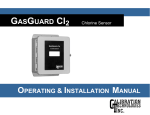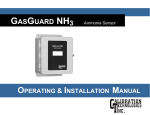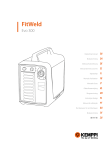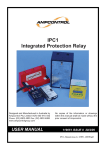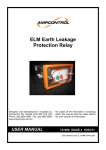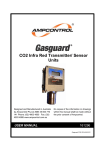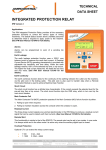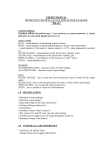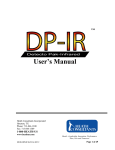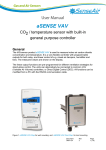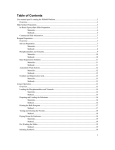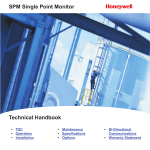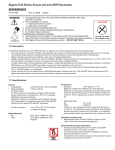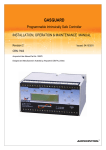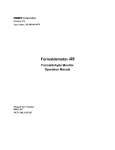Download gasguard sensor user manual issue 3
Transcript
SENSOR UNITS Designed and Manufactured in Australia by Ampcontrol Pty Limited ACN 000 915 542 Phone: (02) 4956 5899 Fax: (02) 4956 5985 www.ampcontrol.com.au USER MANUAL No copies of the information or drawings within this manual shall be made without the prior consent of Ampcontrol. E08975 ISSUE 3 26/05/04 Gasguard_Manual_Issue_3_E08975_260504.pdf GASGUARD SENSOR USER MANUAL ISSUE 3 IMPORTANT WARNINGS AND ADVICE Copyright Notice No part of this publication may be reproduced, transmitted or transcribed into any language by any means without the express written permission of Ampcontrol Pty Ltd, 250 Macquarie Road Warners Bay, NSW 2282, Australia. 1. The sensors should not be stored in areas that contain solvent vapours. Some of these vapours are known to create false "high" zero points and may even damage the sensor electrodes. Similarly, the sensor should not be exposed to high levels of solvent vapours while in operation. 2. This equipment has been designed to detect hazardous gases and vapours and to give warning before they reach dangerous conditions. In order to ensure that the equipment will warn of dangerous situations it is essential that the instructions in this manual be read, understood and followed. It is further stressed that the effectiveness of the device depends heavily on the user who is responsible for its correct application, use and regular maintenance. 3. During start up, electrochemical sensors often require loop currents in excess of 20mA. The Ampcontrol toxic-gas sensors described herein are limited to a maximum of 30mA. It is essential that the circuit into which they are connected is capable of delivering at least 30mA without compromising either Intrinsic Safety (if applicable) or the specifications of monitoring equipment. 4. Note the maximum gas to be applied to any sensor, as per Table 2.1. Maximum levels must not be exceeded. Disclaimer Ampcontrol Pty Ltd will make no warranties as to the contents of this documentation and specifically disclaims any implied warranties or fitness for any particular purpose. Ampcontrol further reserves the right to alter the specification of the system and/or manual without obligation to notify any person or organisation of these changes. Before You Begin We would like to thank you for purchasing the Ampcontrol Gasguard Products. To become completely familiar with this equipment and to ensure correct operation, we recommend that you take the time to read this user manual thoroughly. CRN: 5119 GASGUARD SENSOR USER MANUAL ISSUE 3 SECTION 1 - DESCRIPTION 1.1 Introduction .........................................1 1.1.1 Gasguard Sensor Unit Dimensions.......................................1 1.2 Sensors..................................................2 1.2.1 1.2.2 1.2.3 1.2.4 1.2.5 1.2.6 1.2.7 1.2.8 SECTION 4 - MAINTENANCE 4.1 4.2 Periodic Maintenance.....................11 Corrective Maintenance..................11 SECTION 5 - EQUIPMENT LIST .............. 11 Toxic Gas Sensors ...........................2 Oxygen Sensor.................................2 Methane Sensor ...............................2 Sensor Cell Specifications................2 Sensor Cell Cross Sensitivity ...........3 Humidity ...........................................3 Pressure Effects ...............................3 Operational Restrictions ...................3 1.3 Amplifier PCB .....................................3 1.3.1 Electrochemical Amplifier PCB.........3 1.3.2 Catalytic Amplifier PCB ....................3 1.4 Enclosures ...........................................4 1.4.1 Stainless Steel Housing....................4 1.5 Sensor Wiring Assembly ..............4 1.6 Specifications.....................................5 SECTION 2 - INSTALLATION 2.1 2.2 2.3 2.4 Installation Guidelines ......................7 Relative Density................................7 Cable Resistance Considerations..................................7 Wiring ...............................................7 Toxic Sensor Schematic...................8 Flammable Sensor Schematic..........8 SECTION 3 – COMMISSIONING AND CALIBRATION ...............................................9 3.1 3.2 3.3 3.4 3.5 3.6 Introduction.......................................9 Preliminary Checks...........................9 Gasguard Display Panel...................9 System Calibration ...........................9 Zero Calibration..............................10 Span Calibration.............................10 CONTENTS GASGUARD SENSOR USER MANUAL ISSUE 3 SECTION 1 - DESCRIPTION 1.1 Introduction For which the following instructions and diagrams are included in this manual: This manual provides commissioning, calibration and maintenance instructions for the Ampcontrol Gasguard Sensor Units. Because the units are passive monitoring devices, operating instructions are not applicable to this equipment. The Gasguard sensor units consist of two types: Electrochemical Oxygen Sensor (O2) • Amplifier PCB Description • Sensor Wiring Diagrams • Part Number 65-6550XXX Electrochemical sensor units. • Part Number 65-6551XXX series is for Catalytic sensor units. series is for Note: Carbon Monoxide Sensor (CO) In the part numbers listed above, XXX represents the chemical symbol for the gas detected by the unit. For example, 65-6550O2 is the part number for an Electrochemical unit designed to detect Oxygen (O2) sensor. Hydrogen Sulphide Sensor (H2S) • Toxic-gas or oxygen sensor cells • Stainless Steel Housing Enclosure Dimensions Unique part numbers in accordance with the following scheme identifies the sensor unit configurations: The chemical symbols for toxic-gases and oxygen are used extensively throughout this manual. • • Catalytic Methane Sensor (CH4) 1.1.1 Gasguard Sensor Unit Dimensions (TOXIC) (FLAMMABLE) 170 198 Figure 1.1 shows the top and front view of the Catalytic and Electrochemical Sensor. Figure 1.1 Dimensions - Catalytic and Electrochemical Sensor -1- GASGUARD SENSOR USER MANUAL ISSUE 3 1.2.2 Oxygen Sensor 1.2 Sensors The Oxygen Sensor is a two-electrode device. Oxygen passes through a permeable membrane and reacts with the electrolyte. An output voltage is then developed which is directly proportional to the partial pressure of the oxygen. 1.2.1 Toxic Gas Sensors Electrochemical toxic-gas sensor cells operate on a principle similar to that of a battery. The gas coming in contact with small electrodes at the surface of the sensor cell causes the sensor to generate a small electrical current. The type of gas and its concentration at the sensor surface determines the electrical output of the sensor. 1.2.3 Methane Gas Sensor The Methane Gas Sensor, which operates on the catalytic combustible gas detection principle, is a small platinum element coated in a catalyst. Electrical current is passed through the platinum wire and the potential of the catalytic element is monitored by a simple Wheatstone Bridge arrangement. Combustible gases, once in contact with the heated catalytic surface of the measuring element, react and cause the surface temperature of the element to rise. Any increase in temperature affects the resistance of the platinum wire, causing a small shift in potential across the Wheatstone Bridge proportional to the concentration of the combustible gas. The sensor is temperature compensated and provides a 4/20mA linear output. The three-electrode toxic-gas sensor consists of a sensing electrode, a counter electrode and a reference electrode separated by a thin layer of electrolyte. The central feature of the toxic-gas sensor is the gaseous diffusion barrier. This limits the flow of gas to the sensing electrode and ensures that the electrochemical activity of the electrode exceeds the amount of gas with which it has to deal. Gas diffusing to the sensing electrode reacts at the surface of the electrode either by oxidation or by reduction, depending on the gas the sensor cell is designed to detect. Electrode materials specially developed and designed for the intended gas catalyse reactions. GAS 1.2.4 Sensor Cell Specifications Specification data for the sensor units is contained in Table 1.1. The table shows specific response data for each of the types of sensor cells. H2S CO O2 CH4 100ppm 300ppm 25% 5% 500ppm 30% 6% <5% FS <5% FS <5% FS <±5% FSS Maximum Drift <10 % per 6 mth <10 % per 6 mth <5 % signal loss per year Repeatability ±1% of Reading ±1% of Reading ±1% of Reading ±1% of Reading Response Time (T90) <30 Seconds <30 Seconds <=15 Seconds <15 Seconds (Typical) Sensing Element Life >3 Years in clean Air >3 Years in clean Air >2 Years in Air >2 Years -40 to +50 -40 to +50 -20 to +50 -10 to +50 Maximum Range Max. Gas Applied Overall Linearity Zero, <±5% FSS per month Sensitivity, <±5% FSS per month Temperature Range ºC Resolution <0.3ppm <3ppm 0.02% 0.10% Humidity (RH non-condensing) 50 – 90% 50 –90% 0 – 99% 0 – 95% Storage Temperature 0 to +20ºC Table 1.1 Sensor Cell Specification Data -2- GASGUARD SENSOR USER MANUAL ISSUE 3 1.2.5 Sensor Cell Cross Sensitivity CO2 CONCENTRATION OXYGEN SENSOR OFFSET 5% 2.2% to allow correct operation. The oxygen is normally provided in the sample stream by air diffusing to the front of the sensor or by diffusion through the sides and rear of the sensor. A few thousand PPM of oxygen is normally sufficient. Continuous exposure to an anaerobic sample gas may cause the sensor to malfunction in spite of the rear oxygen access paths. Because of the need for some oxygen access, sensors should not be totally immersed in an anaerobic gas mixture. Since calibration normally involves exposing the sensor to gas for a relatively short period, the calibration gas need not contain oxygen. Sufficient oxygen is supplied from ambient air through the side and back access paths for a limited time. 10% 3.5% 1.2.9 Poisoning of Sensors (Contamination) The cross sensitivity of the various sensor cells to commonly occurring gases are listed in Section 1.6, Page 5. The Oxygen Sensor Cell is slightly cross sensitive with CO2 (Carbon Dioxide), the presence of CO2 creates an offset in the oxygen sensor reading depending on the CO2 concentration. High levels of or long exposure to certain compounds may poison the catalytically active detector filament thereby reducing or destroying its sensitivity. Table 1.2 Oxygen Sensor Offset For the Carbon Monoxide (CO) Sensor Cell, the crosssensitivity to other gases such as Hydrogen Sulphide (H2S), is significantly reduced by use of a filter, which is part of the sensor cell. In normal use the filter is designed to outlast the sensor cell; however it is not capable of withstanding continuous high levels, such as 100ppm, or more of interfering gases. Among these compounds are halides, sulphur compounds, leaded petrol, silanes, silicates and other produces with silicon. Products such as aerosol sprays, polishes, waxes and lubricants with silicones and noncatalysed silicone rubbers such as “silastic”, phosphate esters, hydraulic fluids – all damage catalytic sensors. Methane gas sensors positively detect the presence of all flammable gases. It is unable to distinguish the difference between gases so the sensor will display a reading if any flammable gas is present. 1.3 Amplifier PCB The purpose of the Amplifier PCB is to convert the lowlevel electrical output of the sensor into a signal capable of driving various types of external indicator equipment such as the Ampcontrol Gasguard 4 Channel Controller. Caution: Exposure to Hydrogen Sulphide gas (H2S) may effect the performance of the Methane sensor (i.e. it may reduce its sensitivity). If the sensor is exposed to H2S gas then it should be Recalibrated. The Amplifier PCB requires a 12VDC operating voltage and transmits a signal of 4/20mA. At the lower end of the range, the 4mA signal level indicates a zero gas concentration. At the upper end of the range the 20mA signal indicates that the sensor cell has detected a full span gas concentration. ZERO and SPAN adjustment reed relays located on the PCB are used for calibration of the sensor. 1.2.6 Humidity Sensors can operate in a condensing atmosphere. In such an environment, a thin film of water forms across the membrane, effectively sealing it and stopping the passage of gas into the electrolyte. On evaporation of this water the sensor usually resumes normal operation. Sensors cannot operate continuously below 15% R.H. because the electrolyte dehydrates. Above 90% R.H. the sensor absorbs excess water vapour and after some time, may appear to leak. Provided the exposure to these extremes of humidity has not been for a long period, the sensors can recover when exposed to R.H. in the range 15% to 90%. 1.3.1 Electrochemical Amplifier PCB The amplifier is designed as a 2-wire, remote transmitting amplifier circuit for connection between a Carbon Monoxide sensor cell, Hydrogen Sulphide sensor cell or oxygen sensor cell and the external indicating equipment. The amplifier electronics is powered from the 4/20mA loop current and amplifies the current generated by the sensor cell when gas is detected. 1.2.7 Pressure Effects The toxic-gas sensors do not exhibit a permanent response to changes of pressure. However, when exposed to sudden pressure changes in the presence of a measured gas they give a peak output that decays after a few seconds. The oxygen sensor reacts to pressure changes. It responds to pressure on a directly proportional basis and therefore, should not be exposed to varying pressures. 1.3.2 Catalytic Amplifier PCB The amplifier is designed as a 3-wire, remote transmitting amplifier circuit for connection between a methane sensor cell and the external indicating equipment. 1.2.8 Operational Restrictions. For proper operation, toxic-gas sensors require a small supply of oxygen to the counter and reference electrodes -3- GASGUARD SENSOR USER MANUAL ISSUE 3 1.4 Enclosures 1.4.1 Stainless Steel Housing The standard Stainless Steel Housing, Part Number 236550LB (shown in Figure 1.1, Page 1), incorporates the Sensor Cell and Amplifier PCB. The housing is robust and is corrosion resistant. It is suitable for almost all applications and provides for easy installation and maintenance. When properly used it gives many years of efficient operation. 1.5 Sensor Wiring Assembly Electrical connections for the various sensor cells are by means of connector pins on the top surface of the sensor cells. A Sensor Wiring Assembly provides the electrical interface between the sensor cell and the Amplifier PCB. The sensor cell plugs into the Connector Board on the Sensor Wiring Assembly and the wiring harness connects to the Amplifier PCB (Connector J6 – Electrochemical / Toxic, Connector J4 – Catalytic / Methane). A second wiring assembly connects the supply and signal connections from the incoming terminals to the Amplifier PCB (Connector J7 – Electrochemical / Toxic, Connector J5 – Catalytic / Methane). See Figures 2.1 and 2.2 Section 2.4, Page 8 for wiring details. -4- GASGUARD SENSOR USER MANUAL ISSUE 3 1.6 Specifications The following table contains general operational specifications for all Gasguard Sensor Units. Table 1.3 should be used in conjunction with Table 1.1, which shows specifications for each of the various types of sensor cells. 1.6.1 Sensor Unit Operational Specifications FACTOR SPECIFICATION Detection Method Electrochemical Catalytic Output 4-20mA 4-20mA Accuracy ± 2% of Reading (O2) ± 5% of Reading (All Others) ± 5% Repeatability ± 1% of Reading ± 1% of Reading Zero Drift (30 Day Period) < 2% of Full Scale < 2% of Full Scale Temperature Range (Continuous) See Table 1.1 See Table 1.1 Humidity Range See Table 1.1 See Table 1.1 Power Requirement 12 VDC at Amplifier; 4–20mA Loop-Powered 12 VDC at Amplifier Sensor Cell Estimated Life >2 Years in Clean Air >2 Years in Clean Air Warranty 1 Year 1 Year Recommended Storage Temperature 0 to 20°C 0 to 20°C Table 1.3 Sensor Unit Operational Specifications -5- GASGUARD SENSOR USER MANUAL ISSUE 3 Acetic Acid 4.0% Reading (% v/v) 1.45 Acetone 2.6% 2.5 1.6.2 Cross Sensitivity Data Gas Concentration Sat. vapour Reading (ppm) 0 Alcohols (i.e. IPA) 1025ppm 0 Ammonia 15% 6.25 Ammonia 100ppm 0 Benzene 1.2% 2.0 Carbon Dioxide 10% 0 n-Butane 1.8% 2.5 Chlorine 1ppm 0 Carbon Monoxide 12.5% 4.0 Gasoline Vapour % range 0 Chlorobenzene 1.3% 1.7 Hydrogen 3000ppm 1000 3.3ppm 2.95 Hydrogen Sulphide 20ppm 0 n-Hexane 1.2% 2.0 Nitrogen Dioxide 10ppm 0 Hydrogen 4.0% 4.0 Nitrogen Oxide 100ppm 25 Methane 5.0% 5.0 Sulphur Dioxide 20ppm 0 Methanol Methyl ethyl kentone n-Pentane 6.7% 4.25 1.9% 2.0 1.4% 2.0 Propane 2.1% 2.5 Toluene 1.2% 2.0 Gas Acetic Acid Concentration Ethanol Table 1.4 Cross Sensitivity Data for Carbon Monoxide Sensor Ammonia 100ppm Reading (ppm) 0 Carbon Dioxide 5000ppm 0 Carbon Monoxide 100ppm <2 Chlorine 10ppm 0 Ethylene 500ppm 0 Hydrogen 1% <0.2 Hydrogen Cyanide 15ppm 1 Isopropanol 600ppm 0 Methane 2.2% <-0.1 Methanol 1000ppm 0 Nitrogen Dioxide 10ppm <-2 Sulphur Dioxide 20ppm <3 Gas Concentration Table 1.6 Cross Sensitivity Data for Methane Sensor Table 1.5 Cross Sensitivity Data for Hydrogen Sulphide Sensor -6- GASGUARD SENSOR USER MANUAL ISSUE 3 SECTION 2 - INSTALLATION Hydrogen Ammonia Hydrogen Cyanide Diborane Carbon Monoxide 2.1 Installation Guidelines To ensure continued reliable operation of the sensor system, the following installation guidelines should be observed: • Select a suitable central location for mounting with good access. The location should be as clean and dry as practicable and at a temperature as close 20°C as practicable. • Mount the sensor unit in a position that minimises the risk of mechanical damage. • Mounting should be to a vertical surface, allowing for easy wiring access and subsequent servicing. It is essential that the sensor be positioned to take into account the expected flow of the gas to be measured. LIGHTER Carbon Dioxide Nitric Oxide Oxygen Silane Phosphine Hydrogen Sulphide Ethylene Oxide Hydrogen Chloride Hydrogen Fluoride Fluorine Ozone Sulphur Dioxide Chlorine Nitrogen Dioxide Germane Arsine Hydrogen Bromide Phosgene 2.2 Relative Density The relative density or buoyancy of the gas or vapour with respect to air is a very important consideration. This determines its propensity to rise or fall when released into the atmosphere. Gases or vapours with buoyancy less than air will tend to rise from the source of release. Conversely, gases or vapours heavier than air will tend to fall and accumulate in concentrations for long periods of time. Normal air movements in and around such gas concentrations will have the inevitable effect of producing zones of highly toxic mixtures. HEAVIER THAN AIR Table 2.1 Gas Density 2.3 Cable Resistance Considerations The Electrochemical Amplifier PCB requires no other operating power except the 4-20mA-loop current. The voltage available at the amplifier must be 12VDC and have a maximum cable resistance of 150 Ohms (See Table 2.2). This knowledge of the characteristics of the gas assists when determining the location of the gas sensor. See Table 2.1 for gas density. For monitoring of heavier-than-air gases, mount the sensor as close as practical to the floor or ground. For monitoring of lighter than air gases, install the sensor unit as high as practical. Conductor Diameter Nearest Area mm Mm2 SWG Loop Resistance Ohms/100M 2.0 1.60 16 1.72 2.5 1.78 15 1.38 3.0 1.95 14 1.14 3.5 2.11 13 0.98 Table 2.2 Nominal Resistance Values for Wire Sizes 2.4 Wiring Figures 2.1 and 2.2, Page 8 show the schematic wiring of the Toxic and Flammable Sensor Units. The amplifier PCB is fitted with plug/screw connectors. This allows the connector to be unplugged from the PCB to attach the wiring and then be plugged back into the board. Gas Density -7- +Sig INCOMING TERMINALS 2 3 4 BLACK RED 1 WHITE +12V GASGUARD SENSOR USER MANUAL ISSUE 3 J7 TRANSMITTER DISPLAY J6 SENSOR 0V +Sig 2 INCOMING TERMINALS 3 4 BLACK RED 1 WHITE +12V Figure 2.1 Electrochemical Sensor Unit Wiring Diagram J5 TRANSMITTER DISPLAY J4 SENSOR Figure 2.2 Catalytic Sensor Unit Wiring Diagram -8- GASGUARD SENSOR USER MANUAL ISSUE 3 SECTION 3 - COMMISSIONING AND CALIBRATION 3.4 System Calibration Before the start of calibration, the system should be left in a powered-up operational (no fault) state to allow the gas sensors to stabilise. However, if such a delay is not practical, observe the meter indications with the sensor in a gas free atmosphere, until there is no appreciable meter movement for a period of time. The system should then be sufficiently stable to allow calibration. 3.1 Introduction Commissioning is the performance of initial checks, adjustments and calibration prior to placing the system in operation for the first time. Calibration, however, is not limited to performance of commissioning. Calibration is also performed throughout the life of the system on a periodic basis and after major repairs to the system. • Calibration of sensors can only be achieved by using the appropriate gas. That is the gas that the sensor is designed to detect. A calibration gas should ideally be about 50% of full scale of the relevant monitor. However, sometimes, due to practical restraints and safety reasons, the gas may be 20% or less of full scale. While calibration at such a low level is not ideal, the resulting inaccuracies are usually within the safety tolerances for the system. • For toxic-gas detection, if reading inaccuracies cannot be avoided, they should always be on the high side for safety reasons. For example, with an actual gas density of 50 PPM, the system may safely display 53 PPM. The opposite is true of oxygen detection; the inaccuracies should always be on the low side. For example with an actual oxygen density of 20.9% in volume of air, the system may safely display 20% Vol. As calibration gases have a tolerance, it is advisable to adjust the system to the highest reading (toxic-gases) or lowest reading (oxygen) in this tolerance to maintain an assured safety margin. • Calibration gas should be applied to the sensor at a rate of approximately 0.5 to 1.0 litre per minute. It is not advisable to leave the gas flow on the sensor any longer than is needed for the output to stabilise and the calibration adjustment to be made. Note that, with some gases, the sensor takes considerable time to reach zero after the gas has been removed. While the output should drop to less than 10% of the applied gas level within several minutes, the last drop to zero could take hours under some conditions. Because of this, do not readjust the zero for some hours after span calibration. During commissioning and subsequent re-calibration, it is vital to ensure that procedures are followed to prevent any abnormal sensor signal from initiating any fault, warn or alarm status indicator, or equipment control function. Consult the relevant control unit manual for details of how to do this. The instruments supplied as complete units have already been calibrated at the factory prior to delivery. However, before putting the system into operation, it is important to check the calibration. This is especially important if the instruments are commissioned some time after delivery. 3.2 Preliminary Checks. Perform the following preliminary checks: a) Verify that all connections are correct and complete as detailed in Section 2. b) Apply power to the system. c) Check that voltage applied to the Amplifier PCB is 12VDC. 3.3 Gasguard Display Panel To assist in fault finding the Gasguard display panel will indicate the following: Display -777 -888 -999 Er CAL SAU PU Description There is no sensor plugged into the amplifier Sensor is faulty/expired Amplifier needs reconfiguration Error has occurred Calibration mode initiated (display blinks when in calibration mode) Calibration settings have been saved Powering Up Table 3.1 -9- GASGUARD SENSOR USER MANUAL ISSUE 3 1 4 5 2 3 6 Figure 3.1 Gasguard Control Panel 3.5 Zero Calibration. Perform Zero Calibration as follows: a) b) c) d) e) Ensure that the sensor is in a fresh air environment, or apply fresh air to the sensor via the calibration plug, in the case of oxygen apply High Purity Nitrogen via the calibration plug. Place the magnetic tip of the calibration pen over the CAL symbol (1) for 5 seconds. Now that the CAL mode is accessed place the magnetic tip over the ZERO symbol (3) for 5 seconds. The display should have a zero reading. To save the zero setting place the magnetic tip over the CAL symbol (1) for 5 seconds. The sensor display (5) will show SAV to confirm that it has saved the zero setting. 3.6 Span Calibration. Perform Span Calibration as follows: a) Apply calibration gas to the sensor at the rate of 0.5 to1 litre per minute. Use a calibration gas of the same density as the most critical measurements to be made. If that is not possible, use gas of between 20% and 50% of the instrument range. For oxygen sensors, ensure the sensor is in fresh air, or apply a gas with an oxygen content of approximately 21 %. b) To adjust the display so that it reads the correct value for the gas applied enter Calibration Mode by placing the magnetic tip of the Calibration pen over the CAL symbol (1) for 5 seconds. Place the magnetic tip of the pen over the UP symbol (4) to increase the display reading and over the DOWN symbol (6) to decrease the display reading. c) Place the magnetic tip over the CAL symbol (1) for 5 seconds once the display reads the correct value for the gas applied. d) Shut off the calibration gas. If the Zero calibration is to be checked, wait for the sensor to stabilise before proceeding. -10- GASGUARD SENSOR USER MANUAL ISSUE 3 Sensor cannot be Spanned or Zeroed: SECTION 4 - MAINTENANCE 4.1 Periodic Maintenance Periodic maintenance consists mainly of scheduled checks to ensure the instrument remains in adjustment and gives the required response to sampled gas. The following maintenance schedule is recommended. a) Check that voltage and polarity applied to the amplifier is correct. b) Check for loose plug and terminal connections. c) If the above is correct and the problem persists, replace the sensor. d) Daily: Verify operation by visually checking the reading on the respective control unit/monitor. If the sensor still cannot be Spanned or Zeroed, replace the Amplifier PCB. Erratic Output: Investigate any abnormal deviations from Zero reading. a) Check that voltage and polarity applied to the Amplifier PCB is correct. Also, check that there are no severe voltage swings, indicating an intermittent fault in the field wiring or control unit. Monthly: a) Check the Zero reading in fresh air or by b) Check for loose plug and terminal connections. accurate measurement of ambient air for a nonzero point; readjust as necessary. c) If the above is correct and the problem persists, replace the sensor. b) Check the Span calibration on a known sample d) If the output is still erratic, replace the Amplifier PCB. of toxic gas in air. Readjust as necessary. As Required: SECTION 5 - EQUIPMENT LIST Replace the toxic-gas sensor whenever it becomes impossible to adjust to Zero, or when the Span adjustment is insufficient to enable adjustment to the calibration gas value. If this occurs, recalibrate the unit as described in Section 3 Commissioning and Calibration. 65-6551-CH4 65-6551-CH4-R05 61-6551-CH4-R10 Following Power Removal: 65-6550-CO-50 If power has been removed from the unit for a long period of time, a re-commissioning check should be carried out. 65-6550-CO-100 65-6550-H2S 4.2 Corrective Maintenance. 65-6550-O2 During fault isolation it is vital to ensure that suitable procedures are followed to prevent any abnormal sensor signal from unintentionally operating any fault, warn or alarm status indicator, or equipment control function. Consult the relevant control unit manual for details as to how to do this. 33-6529L 33-1033 75-6550-V4-LB 75-6551-V4-LB There are only two active replaceable units in the sensor system, the Amplifier PCB and the gas sensor. Therefore, fault isolation is limited to the following possible faults and remedies. 65-6511XXX 65-0660L No 4/20mA Output: a) Check that voltage applied to the Amplifier PCB is 12VDC and that polarity is correct. If not correct, rectify. b) Check for loose plug and terminal connections. c) If Step a) above is correct and the problem persists, replace the Amplifier PCB. 13-7000LC -11- Methane Gas Sensor c/w Display Methane Gas Sensor c/w Remote Head on a 5m lead and Display Methane Gas Sensor c/w remote head on a 10m lead and Display Carbon Monoxide Gas Sensor c/Display – 0-50ppm Carbon Monoxide Gas Sensor c/Display – 0-100ppm Hydrogen Sulphide Gas Sensor c/w Display Oxygen Gas Sensor c/w display Replaceable Filter for toxic sensors Replacement Filter Membrane Replacement Toxic Amplifier PCB Replacement Catalytic Amplifier PCB Replacement Toxic Sensor Cell (XXX denotes gas type) Replacement Methane Sensor Cell Calibration Pen















